MuxLab Digital Audio Converter, Dolby® Digital Installation guide
- Category
- Audio converters
- Type
- Installation guide

© MuxLab Inc. 2012 94-000721-A SE-000721-A
8495 Dalton Road, Mount Royal, Quebec, Canada. H4T 1V5
Tel: (514) 905-0588 Fax: (514) 905-0589
Toll Free (North America): (877) 689-5228
E-mail: [email protected]
m
URL: www.muxlab.co
m
Specifications
Environment
Digital Audio, Dolby Digital or LPCM
Devices
DVD, CD Players, TV, PC, laptops.
Transmission
Transparent to the user
Signals
Dolby Digital & 2 channel LPCM
Connectors
One (1) Coaxial connector
One (1) TOSLink Connector.
Two (2) RCA Connectors.
Note: Audio cables not included.
Switch
Selects between SPDIF and TOSlink
Distortion
<0.001% @ 1KHz
SNR
> 90 dB (20Hz – 20 KHz)
Sample Rate
32, 44.1, 48 and 96 KHz
Bit Depth
24 bit S/PDIF compress & uncompress bitstream
Power Supply
One (1) 110-240V/5VDC power supplies with interchangeable
blades
Power Consumption
1.75 Watt
Temperature
Operating: 0° to 40°C Storage: -20° to 85°C
Humidity: Up to 95% non-condensing
Enclosure
ABS fire retardant plastic
Dimensions
2.4” x 2.25” x 1.0” (6.1 x 5.5 x 2.5 cm)
Weight
1.0 lb (0.45 kg)
Compliance
Regulatory: FCC, CE, RoHS Flammability: 94V0
Warranty
2 years
Order Information
500081 Digital Audio Converter, Dolby Digital
Trademark acknowledgments
All products or services names mentioned in this document may be trademarks of
the companies with which they are associated. Manufactured under license from
Dolby Laboratories. Dolby and the double-D symbol are trademarks of Dolby
Laboratories.
Digital Audio Converter, Dolby Digital
500081
Quick Installation Guide
Overview
The Digital Audio Converter, Dolby Digital (500081) converts one LPCM-encoded or
one Dolby Digital coaxial (S/PDIF) or optical (TOSLink) digital audio signal to a
standard left/right analog audio output, thereby allowing a digital audio source such as a
DVD or CD player without RCA analog audio output to be connected to an audio-video
receiver or TV.
Applications
Applications include commercial and residential audio systems, boardroom systems,
collaborative PC systems, and medical information systems.
Installation
1. Identify the connectors on the Digital Audio Converter as indicated on the product
panels.

© MuxLab Inc. 2012
2. To install the Digital Audio Converter:
2a. Connect the converter input to the digital audio source with an Optical (TOSLink)
or 75-ohm coaxial (S/PDIF) cable.
2b. Set the input switch to the appropriate signal.
2c. Connect the converter output to the analog audio receiver with a stereo audio
compliant cable.
3. Connect the 5 VDC power supply to the converter first, and then plug the power
supply into an AC power outlet. If power is present, the green power LED of the
Digital Audio Converter will be ON.
Note: Power-on the Digital Audio Converter only after all connections are made.
4. Power-on the audio source and receiver and verify the audio quality.
5. The following diagrams shows the final configuration.
Troubleshooting
The following table describes some of the symptoms, probable causes and possible solutions
in regard to the installation of the Digital Audio Converter:
Symptom
LEDs
Probable
Cause
Possible
Solutions
Power Lock
No Sound OFF OFF No power • Check power connections
No Sound ON OFF Optical/Coaxial Cable • Check the Optical/Coaxial cables.
No Sound ON ON Stereo audio cable • Check the stereo audio cable.
No Sound ON ON Wrong input on receiver • Check if the selected input on the
receiver can receive analog stereo
audio.
No Sound ON ON Audio source outputs a
unsupported compressed
bitstream such as DTS
• Configure the source to only
output a uncompressed LPCM or
Dolby Digital bitstream
Choppy
sound
ON ON Weak Connections • Check cable connection
• Check the Optical/Coaxial Cable
Quality.
If you still cannot diagnose the problem, please call MuxLab Customer Technical Support at
877-689-5228 (toll-free in North America) or (+1) 514-905-0588 (International).
-
 1
1
-
 2
2
MuxLab Digital Audio Converter, Dolby® Digital Installation guide
- Category
- Audio converters
- Type
- Installation guide
Ask a question and I''ll find the answer in the document
Finding information in a document is now easier with AI
Related papers
-
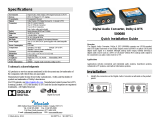 MuxLab Digital Audio Converter, Dolby & DTS Installation guide
MuxLab Digital Audio Converter, Dolby & DTS Installation guide
-
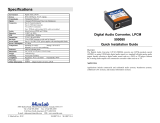 MuxLab Digital Audio Converter (DAC) Installation guide
MuxLab Digital Audio Converter (DAC) Installation guide
-
 MuxLab HDMI Repeater Installation guide
MuxLab HDMI Repeater Installation guide
-
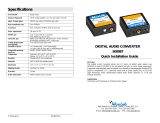 MuxLab Digital Audio Standards Converter Installation guide
MuxLab Digital Audio Standards Converter Installation guide
-
MuxLab HDMI 4X1 Switcher Installation guide
-
MuxLab HDMI 4X1 Switcher Installation guide
-
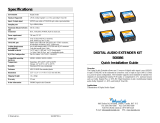 MuxLab Digital Audio Extender Installation guide
MuxLab Digital Audio Extender Installation guide
-
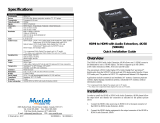 MuxLab HDMI to HDMI Operating instructions
MuxLab HDMI to HDMI Operating instructions
-
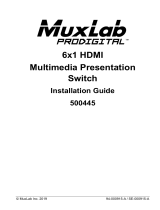 MuxLab 6x1 2.0 Multimedia Presentation Switch Installation guide
MuxLab 6x1 2.0 Multimedia Presentation Switch Installation guide
-
 MuxLab HDMI Video Scaler Operating instructions
MuxLab HDMI Video Scaler Operating instructions









